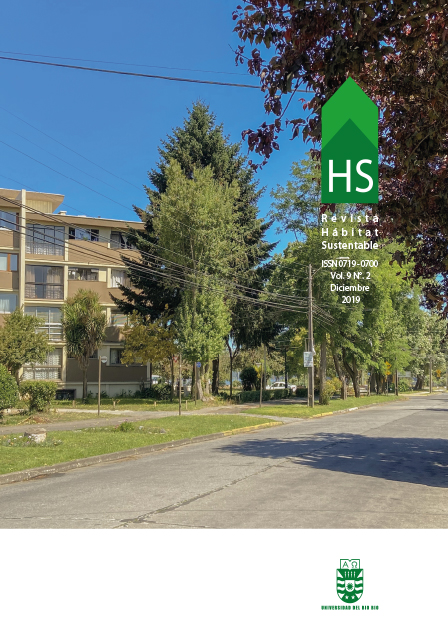Potencial de enfriamiento geotérmico para edificaciones en zona árida
DOI:
https://doi.org/10.22320/07190700.2019.09.02.04Palabras clave:
arquitectura bioclimática, sistemas pasivos, ahorro energéticoResumen
En el presente artículo se analiza cuantitativamente el potencial geotérmico para ser usado como sistema pasivo de refrescamiento edilicio en un ambiente árido urbano, tomando como caso de estudio el Área Metropolitana de San Juan (República Argentina). Se utiliza como insumo la base de datos climáticos y meteorológicos correspondiente a la estación verano, obtenida en el Complejo Universitario Islas Malvinas (CUIM) de la Universidad Nacional de San Juan, lugar donde el Instituto de Estudios en Arquitectura Ambiental “Arq. Alberto Papparelli” (INEAA) registra: temperatura del suelo, a distintas profundidades, y parámetros meteorológicos ambientales. Los resultados están relacionados con la identificación de gradientes y profundidades óptimas para el aprovechamiento del recurso como Sistema Pasivo de Refrescamiento Geotérmico, a fin de proveer condiciones de confort higrotérmico en zonas urbanas áridas durante el verano. En promedio, se obtiene una diferencia máxima de 8,7ºC entre la temperatura del aire y la de la tierra, a una profundidad de 3m. La longitud de los conductos enterrados necesaria resulta de 64m para una velocidad del aire de 3m/s, la cual se reduce a 27m para una velocidad de aire de 2m/s.
Descargas
Citas
Bansal, V., Misra, R., Agrawal, G.D. y Mathur, J. (2010). Performance analysis of earth-pipe-air heat exchanger for
summer cooling. Energy and Buildings, 42 (5), 645-648.
Baver, L., Gardner, W. y Gardner, W. (1991). Física de suelos. Primera ed. México: Grupo Noriega.
Bisoniya, T. (2015). Design of earth–air heat exchanger system. Geothermal Energy, 3(18). DOI 10.1186/s40517-015-0036-2
Cabezas, A. (2013). Eficiencia energética a través de utilización de pozos canadienses con el análisis de datos de un caso real “Casa Pomaret”. Tesina final de Master en Edificación. Universidad Politécnica de Catalunya – UPC, Barcelona.
Cohenca, D., Bordas, M., Schvartzman, D. (2013). Caracterización de las propiedades térmicas del suelo – Campus universitario San Lorenzo –Paraguay. En Acta de la XXXVI Reunión de Trabajo de la Asociación Argentina de Energías Renovables y Medio Ambiente. Vol. 1 (pp. 08.43-08.52). Salta: ASADES.
De Paepe, M. y Janssens, A. (2003). Thermo-hydraulic design of earth-air heat exchangers. Energy and Buildings, 35(4), 389-397.
Flores Larsen, S., Hernández, A., Lesino, G. y Salvo, N. (2001). Measurement and simulation of the thermal behavior
of a massive building with passive solar conditioning. En Proceedings of VII International Building Simulation Congress
(pp. 183-190), Río de Janeiro, Brazil.
Flores Larsen, S. y Lesino, G. (2001). Modelización de intercambiadores tierra-aire para acondicionamiento térmico
de edificios. En Actas del 8º Congreso Latinoamericano de Transferencia de Calor y Materia (LATCYM 2001), México.
Givoni, B. (1984). Curso Extensivo “Acondicionamiento térmico para edificios en verano, mediante emergías naturales”.
Mendoza (5 al 28 de mayo).
Hazim Zaki, H., Al-musaed, A. y Khalil, A. (2005). En Thermal earth inertia such a source of energy for bio-sustainable house. The 2005 World Sustainable Building Conference, Tokyo.
Hollmuller, P. y Lachal, B. (2005). Buried pipe systems with sensible and latent heat. Exchange validation of numerical
simulation against analytical solution and long-term monitoring. Montreal: Escuela Politécnica de Montreal.
Iannelli, L., Bezzo, E., Bermejo, A., Cozza, P., Fiora, J., Niño, J., Prieto, R., Romero P., Gil S. (2013). La tierra como acondicionador natural de ambientes. En Primer Encuentro Latinoamericano de Uso Racional y Eficiente de la Energía (25-27 septiembre 2013), Universidad de Buenos Aires (UBA), Instituto Nacional de Tecnología Industrial (INTI).
Iannelli, L. y Gil, S. (2012). Acondicionamiento térmico de aire usando energía geotérmica-ondas de calor. Lat. Am. J. Phys. Educ., 6(1), 100.
Kurbán, A., Cúnsulo, M., Álvarez, A., Montilla, E. y Ortega, A. (2015). The role of bioclimatic architecture in the reduction of the emission of CO2 in arid environments. Environmental Science, 11(6), 171-178.
Kurbán, A., Cúnsulo, M., Matar, M., Ripoll, V. y Ortega, A. (2017). Social bioclimatic urban prototype in arid area. Energy and economic assessment. International Journal of Applied Science and Technology, 7(4).
Neila, F. y Bedoya, C. (2001). Técnicas arquitectónicas y constructivas de acondicionamiento ambiental. 2ª Edición.
Madrid: Murilla –Lería.
Ortega A., Montilla E. y Cúnsulo M. (2013). Clima urbano árido. Base de datos para estudios del Área Metropolitana de San Juan. AVERMA, 17, 11.19 a 11.26.
Pittaluga, A., Ocaña, E. y Cortez, V. (2019). Estudio de suelos en el área del Complejo Universitario Islas Malvinas (CUIM). Rivadavia - Provincia de San Juan. (Inédito).
Rouag, A., Benchabane, A. y Mehdid, C. (2018). Thermal design of Earth-to-Air Heat Exchanger. Part I. A new transient semianalytical model for determining soil temperature. Journal of Cleaner Production, 182, 538-544.
Tiwari, G., Singh, V., Joshi, P., Shyam, D. A., Prabhakant, G. A. (2014). Design of an Earth Air Heat Exchanger (EAHE) for Climatic Condition of Chennai, India. Open Environmental Sciences, 8, 24-34.
Vidal J. y Vidal O. (2011). Instalaciones de ventilación. En: Sistemas Eficientes de Climatización (pp. 2-8). Barcelona: La Salle - Universitat Ramón Llull.
Xamán, J., Hernández-Pérez, I., Arce, J. Álvarez, G., Ramírez-Dávila, L. y Noh-Pat, F. (2014). Numerical study of earth-to-air heat exchanger: the effect of thermal insulation. Energy and Buildings, 85(Suppl. C), 356-361.
Descargas
Publicado
Cómo citar
Número
Sección
Licencia
El contenido de los artículos que se publican en cada número de Hábitat Sustentable, es responsabilidad exclusiva de los autores y no representan necesariamente el pensamiento ni comprometen la opinión de la Universidad del Bío-Bío.
Los autores/as conservarán sus derechos de autor y garantizarán a la revista el derecho de primera publicación de su obra, el cuál estará simultáneamente sujeto a la Licencia de Reconocimiento de Creative Commons CC BY-SA que permite a otros compartir-copiar, transformar o crear nuevo material a partir de esta obra con fines no comerciales, siempre y cuando se reconozcan la autoría y la primera publicación en esta revista, y sus nuevas creaciones estén bajo una licencia con los mismos términos.











 Programa de Información Científica/Concurso Fondos de Publicación de Revistas Científicas 2018/ Proyecto Mejoramiento de Visibilidad de Revistas UBB (Código:FP180007)
Programa de Información Científica/Concurso Fondos de Publicación de Revistas Científicas 2018/ Proyecto Mejoramiento de Visibilidad de Revistas UBB (Código:FP180007) 





